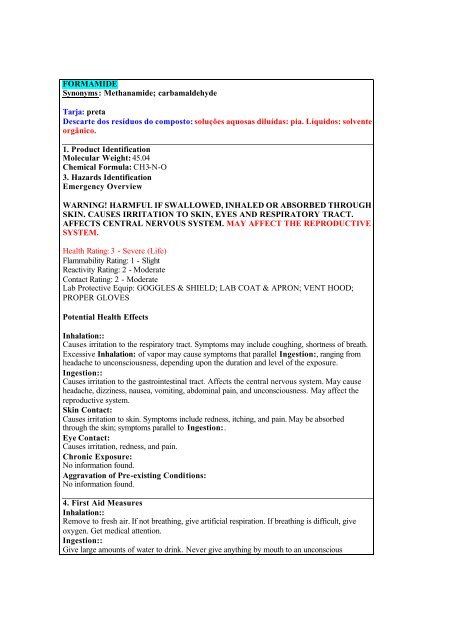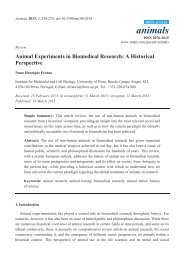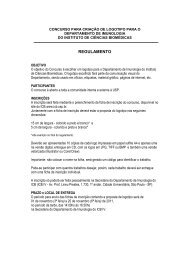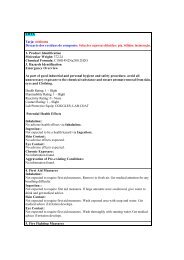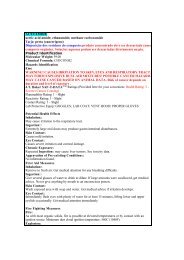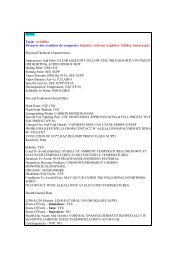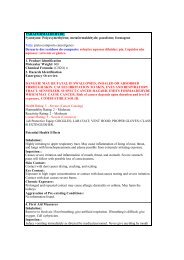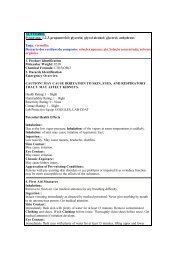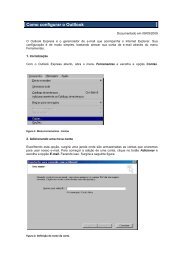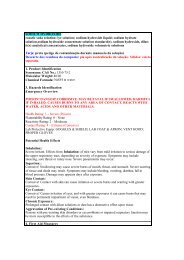FORMAMIDE Synonyms: Methanamide; carbamaldehyde Tarja ...
FORMAMIDE Synonyms: Methanamide; carbamaldehyde Tarja ...
FORMAMIDE Synonyms: Methanamide; carbamaldehyde Tarja ...
You also want an ePaper? Increase the reach of your titles
YUMPU automatically turns print PDFs into web optimized ePapers that Google loves.
<strong>FORMAMIDE</strong><br />
<strong>Synonyms</strong> : <strong>Methanamide</strong>; <strong>carbamaldehyde</strong><br />
<strong>Tarja</strong>: preta<br />
Descarte dos resíduos do composto: soluções aquosas diluídas: pia. Líquidos: solvente<br />
orgânico.<br />
1. Product Identification<br />
Molecular Weight: 45.04<br />
Chemical Formula: CH3-N-O<br />
3. Hazards Identification<br />
Emergency Overview<br />
WARNING! HARMFUL IF SWALLOWED, INHALED OR ABSORBED THROUGH<br />
SKIN. CAUSES IRRITATION TO SKIN, EYES AND RESPIRATORY TRACT.<br />
AFFECTS CENTRAL NERVOUS SYSTEM. MAY AFFECT THE REPRODUCTIVE<br />
SYSTEM.<br />
Health Rating: 3 - Severe (Life)<br />
Flammability Rating: 1 - Slight<br />
Reactivity Rating: 2 - Moderate<br />
Contact Rating: 2 - Moderate<br />
Lab Protective Equip: GOGGLES & SHIELD; LAB COAT & APRON; VENT HOOD;<br />
PROPER GLOVES<br />
Potential Health Effects<br />
Inhalation::<br />
Causes irritation to the respiratory tract. Symptoms may include coughing, shortness of breath.<br />
Excessive Inhalation: of vapor may cause symptoms that parallel Ingestion:, ranging from<br />
headache to unconsciousness, depending upon the duration and level of the exposure.<br />
Ingestion::<br />
Causes irritation to the gastrointestinal tract. Affects the central nervous system. May cause<br />
headache, dizziness, nausea, vomiting, abdominal pain, and unconsciousness. May affect the<br />
reproductive system.<br />
Skin Contact:<br />
Causes irritation to skin. Symptoms include redness, itching, and pain. May be absorbed<br />
through the skin; symptoms parallel to Ingestion:.<br />
Eye Contact:<br />
Causes irritation, redness, and pain.<br />
Chronic Exposure:<br />
No information found.<br />
Aggravation of Pre-existing Conditions:<br />
No information found.<br />
4. First Aid Measures<br />
Inhalation::<br />
Remove to fresh air. If not breathing, give artificial respiration. If breathing is difficult, give<br />
oxygen. Get medical attention.<br />
Ingestion::<br />
Give large amounts of water to drink. Never give anything by mouth to an unconscious
person. Get medical attention.<br />
Skin Contact:<br />
Immediately flush skin with plenty of water for at least 15 minutes while removing<br />
contaminated Clothing and shoes. Get medical attention. Wash Clothing before reuse.<br />
Thoroughly clean shoes before reuse.<br />
Eye Contact:<br />
Immediately flush eyes with plenty of water for at least 15 minutes, lifting upper and lower<br />
eyelids occasionally. Get medical attention.<br />
5. Fire Fighting Measures<br />
Fire:<br />
Flash point: 154C (309F) OC<br />
Moderate fire hazard when heated.<br />
Explosion:<br />
Above the flash point, explosive vapor-air mixtures may be formed.<br />
Fire Extinguishing Media:<br />
Water spray, dry chemical, alcohol foam, or carbon dioxide. Water or foam may cause<br />
frothing.<br />
Special Information:<br />
In the event of a fire, wear full protective Clothing and NIOSH-approved self-contained<br />
breathing apparatus with full facepiece operated in the pressure demand or other positive<br />
pressure mode. Fires involving formamide are likely to produce very toxic gases such as<br />
carbon monoxide and ammonia, which should not be inhaled.<br />
6. Accidental Release Measures<br />
Ventilate area of leak or spill. Wear appropriate personal protective equipment as specified in<br />
Section 8. Isolate hazard area. Keep unnecessary and unprotected personnel from entering.<br />
Contain and recover liquid when possible. Collect liquid in an appropriate container or absorb<br />
with an inert material (e. g., vermiculite, dry sand, earth), and place in a chemical waste<br />
container. Do not use combustible materials, such as saw dust. Do not flush to sewer!<br />
J. T. Baker SOLUSORB® solvent adsorbent is recommended for spills of this product.<br />
7. Handling: and Storage<br />
Keep in a tightly closed container, stored in a cool, dry, ventilated area. Protect against<br />
physical damage. Isolate from incompatible substances. Containers of this material may be<br />
hazardous when empty since they retain product residues (vapors, liquid); observe all<br />
warnings and precautions listed for the product.<br />
8. Exposure Controls/Personal Protection<br />
Airborne Exposure Limits:<br />
ACGIH Threshold Limit Value (TLV):<br />
10 ppm (TWA) Skin<br />
NIOSH(REL): 10 ppm (TWA) Skin<br />
Ventilation System:<br />
A system of local and/or general exhaust is recommended to keep employee exposures below<br />
the Airborne Exposure Limits. Local exhaust ventilation is generally preferred because it can<br />
control the emissions of the contaminant at its source, preventing dispersion of it into the<br />
general work area. Please refer to the ACGIH document, Industrial Ventilation, A Manual of<br />
Recommended Practices, most recent edition, for details.<br />
Personal Respirators (NIOSH Approved):
If the exposure limit is exceeded and engineering controls are not feasible, wear a supplied air,<br />
full-facepiece respirator, airlined hood, or full-facepiece self-contained breathing apparatus.<br />
Breathing air quality must meet the requirements of the OSHA respiratory protection standard<br />
(29CFR1910.134).<br />
Skin Protection:<br />
Wear impervious protective Clothing, including boots, gloves, lab coat, apron or coveralls, as<br />
appropriate, to prevent skin contact.<br />
Eye Protection:<br />
Use chemical safety goggles and/or a full face shield where splashing is possible. Maintain eye<br />
wash fountain and quick-drench facilities in work area.<br />
9. Physical and Chemical Properties<br />
Appearance: Clear, colorless liquid.<br />
Odor: Faint ammonia odor.<br />
Solubility: Infinitely soluble.<br />
Density: 1.13 @ 20C/4C<br />
pH: 7.1<br />
% Volatiles by volume @ 21C (70F): 100<br />
Boiling Point: 210C (410F)<br />
Melting Point: 2 - 3C (36 - 37F)<br />
Vapor Density (Air=1): 1.55<br />
Vapor Pressure (mm Hg): 1 @ 70.5C (158F)<br />
Evaporation Rate (BuAc=1): < 1<br />
10. Stability and Reactivity<br />
Stability:<br />
Stable under ordinary conditions of use and Storage. Absorbs moisture from air.<br />
Hazardous Decomposition Products:<br />
Burning may produce ammonia, carbon monoxide, carbon dioxide, nitrogen oxides. At boiling<br />
point: ammonia, carbon monoxide and hydrogen cyanide.<br />
Hazardous Polymerization:<br />
Will not occur.<br />
Incompatibilities:<br />
Acids, alkalines, iodine, pyridine, and sulfur trioxide. Copper, brass, lead and rubber are<br />
attacked by formamide.<br />
Conditions to Avoid:<br />
Heat, flames, ignition sources and incompatibles.<br />
11. Toxicological Information<br />
Toxicological Data:<br />
Oral rat LD50: 5570 mg/kg; investigated as a tumorigen, mutagen, reproductive effector.<br />
Reproductive Toxicity:<br />
Has shown teratogenic effects in laboratory animals.<br />
12. Ecological Information<br />
Environmental Fate:<br />
When released into the soil, this material may biodegrade to a moderate extent. When released<br />
into the soil, this material is expected to leach into groundwater. This material has an<br />
estimated bioconcentration factor (BCF) of less than 100. This material is not expected to<br />
significantly bioaccumulate. When released into the air, this material is expected to be readily<br />
degraded by reaction with photochemically produced hydroxyl radicals. When released into<br />
the air, this material is expected to have a half-life of less than 1 day.
Environmental Toxicity:<br />
No information found.


